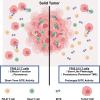BiTE secretion by adoptively transferred stem-like T cells improves FRα+ ovarian cancer control
- PMID: 37647218
- PMCID: PMC10314690
- DOI: 10.1136/jitc-2023-006863
BiTE secretion by adoptively transferred stem-like T cells improves FRα+ ovarian cancer control
Abstract
Background: Cancer immunotherapies can produce complete therapeutic responses, however, outcomes in ovarian cancer (OC) are modest. While adoptive T-cell transfer (ACT) has been evaluated in OC, durable effects are rare. Poor therapeutic efficacy is likely multifactorial, stemming from limited antigen recognition, insufficient tumor targeting due to a suppressive tumor microenvironment (TME), and limited intratumoral accumulation/persistence of infused T cells. Importantly, host T cells infiltrate tumors, and ACT approaches that leverage endogenous tumor-infiltrating T cells for antitumor immunity could effectively magnify therapeutic responses.
Methods: Using retroviral transduction, we have generated T cells that secrete a folate receptor alpha (FRα)-directed bispecific T-cell engager (FR-B T cells), a tumor antigen commonly overexpressed in OC and other tumor types. The antitumor activity and therapeutic efficacy of FR-B T cells was assessed using FRα+ cancer cell lines, OC patient samples, and preclinical tumor models with accompanying mechanistic studies. Different cytokine stimulation of T cells (interleukin (IL)-2+IL-7 vs IL-2+IL-15) during FR-B T cell production and the resulting impact on therapeutic outcome following ACT was also assessed.
Results: FR-B T cells efficiently lysed FRα+ cell lines, targeted FRα+ OC patient tumor cells, and were found to engage and activate patient T cells present in the TME through secretion of T cell engagers. Additionally, FR-B T cell therapy was effective in an immunocompetent in vivo OC model, with response duration dependent on both endogenous T cells and FR-B T cell persistence. IL-2/IL-15 preconditioning prior to ACT produced less differentiated FR-B T cells and enhanced therapeutic efficacy, with mechanistic studies revealing preferential accumulation of TCF-1+CD39-CD69- stem-like CD8+ FR B T cells in the peritoneal cavity over solid tumors.
Conclusions: These findings highlight the therapeutic potential of FR-B T cells in OC and suggest FR-B T cells can persist in extratumoral spaces while actively directing antitumor immunity. As the therapeutic activity of infused T cell therapies in solid tumor indications is often limited by poor intratumoral accumulation of transferred T cells, engager-secreting T cells that can effectively leverage endogenous immunity may have distinct mechanistic advantages for enhancing therapeutic responses rates.
Keywords: Cell Engineering; Immunity, Cellular; Immunotherapy; Immunotherapy, Adoptive; Tumor Microenvironment.
© Author(s) (or their employer(s)) 2023. Re-use permitted under CC BY-NC. No commercial re-use. See rights and permissions. Published by BMJ.
Conflict of interest statement
Competing interests: AJRM, TT, and KO are inventors on provisional patents pertaining to the development and use of BiTE-secreting T cells in cancer. KO is a co-founder of Tactiva Therapeutics. All other authors have no financial conflicts of interest to disclose.
Figures






Similar articles
-
Human macrophages engineered to secrete a bispecific T cell engager support antigen-dependent T cell responses to glioblastoma.J Immunother Cancer. 2020 Oct;8(2):e001202. doi: 10.1136/jitc-2020-001202. J Immunother Cancer. 2020. PMID: 33122397 Free PMC article.
-
Targeting the immune microenvironment for ovarian cancer therapy.Front Immunol. 2023 Dec 18;14:1328651. doi: 10.3389/fimmu.2023.1328651. eCollection 2023. Front Immunol. 2023. PMID: 38164130 Free PMC article. Review.
-
B cells imprint adoptively transferred CD8+ T cells with enhanced tumor immunity.J Immunother Cancer. 2022 Jan;10(1):e003078. doi: 10.1136/jitc-2021-003078. J Immunother Cancer. 2022. PMID: 35017148 Free PMC article.
-
Modification of cytokine-induced killer cells with folate receptor alpha (FRα)-specific chimeric antigen receptors enhances their antitumor immunity toward FRα-positive ovarian cancers.Mol Immunol. 2017 May;85:293-304. doi: 10.1016/j.molimm.2017.03.017. Epub 2017 Mar 27. Mol Immunol. 2017. PMID: 28360017
-
IL-10 Signaling in the Tumor Microenvironment of Ovarian Cancer.Adv Exp Med Biol. 2021;1290:51-65. doi: 10.1007/978-3-030-55617-4_3. Adv Exp Med Biol. 2021. PMID: 33559854 Review.
Cited by
-
Potent and durable control of mesothelin-expressing tumors by a novel T cell-secreted bi-specific engager.J Immunother Cancer. 2025 Mar 13;13(3):e010063. doi: 10.1136/jitc-2024-010063. J Immunother Cancer. 2025. PMID: 40081946 Free PMC article.
-
CD22 CAR-T cells secreting CD19 T-cell engagers for improved control of B-cell acute lymphoblastic leukemia progression.J Immunother Cancer. 2025 Apr 30;13(4):e009048. doi: 10.1136/jitc-2024-009048. J Immunother Cancer. 2025. PMID: 40306957 Free PMC article.
-
Tertiary lymphoid structures: exploring opportunities to improve immunotherapy in ovarian cancer.Front Immunol. 2025 May 22;16:1473969. doi: 10.3389/fimmu.2025.1473969. eCollection 2025. Front Immunol. 2025. PMID: 40475770 Free PMC article. Review.
-
Advances and obstacles of T cell-based immunotherapy in gynecological malignancies.Mol Cancer. 2025 Jul 26;24(1):207. doi: 10.1186/s12943-025-02411-w. Mol Cancer. 2025. PMID: 40713697 Free PMC article. Review.
-
Developing Folate-Conjugated miR-34a Therapeutic for Prostate Cancer: Challenges and Promises.Int J Mol Sci. 2024 Feb 9;25(4):2123. doi: 10.3390/ijms25042123. Int J Mol Sci. 2024. PMID: 38396800 Free PMC article.
References
Publication types
MeSH terms
Substances
Grants and funding
LinkOut - more resources
Full Text Sources
Medical
Molecular Biology Databases
Research Materials
